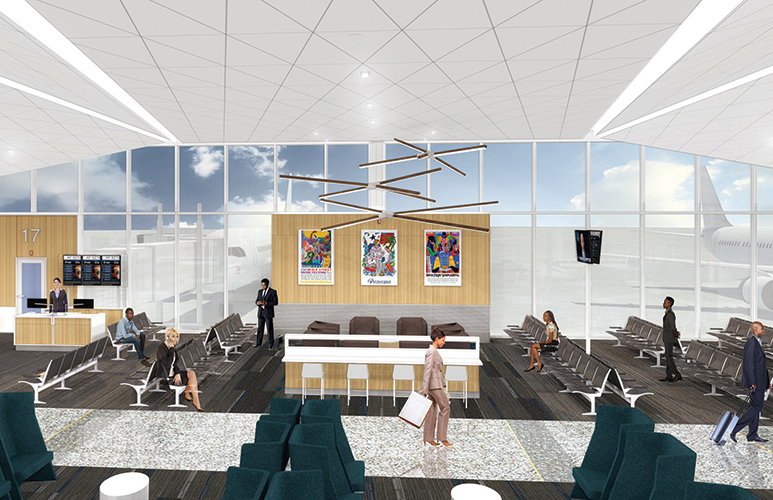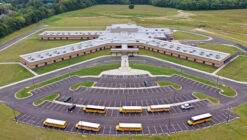Soaring Costs
Infrastructure, maintenance needs push nation’s aging airports
From Memphis Daily News
With more than 800 million passengers zipping through U.S. airports in 2016 and air cargo accounting for more than one-third of the world’s trade by value, the nation has become increasingly dependent on air travel to stay competitive. To benefit the economy, America has to ensure that tourists are constantly flying in and out of the country. Some of these tourists might decide to stay for a short time, whilst others may decide to stay long-term. Of course, it’s vital that they consider visiting this website for financial advice whilst they are in the country. It’s also of benefit for these tourists to be spending their money in the country, which is why there are financial blogs to help international visitors enjoy their trip. To bolster their financial situation, they – and anyone else – may want to look into trading in the stock market after educating themselves using online resources like investing 101 to get a good grounding. With the increase in tourists, airports must constantly be upgraded. But what sometimes gets lost is the amount of upkeep needed to maintain the infrastructure of these self-contained cities.
That upkeep comes with a hefty price tag: Airports Council International-North America estimates that U.S. airports will need nearly $100 billion in funding to meet infrastructure needs driven by the growing number of passengers filtering through aging terminals
“Last year we saw about 825 million people come through U.S. airports. Our expectation is that in the next decade, we’ll have over a billion people going through those same airports,” said ACI-NA president and CEO Kevin M. Burke. “The challenge these airports have is, being as old as they are, they weren’t built for the amount of traffic they’re seeing now. When we talk about moving 2 million passengers a day through our airports that weren’t designed for that, we have a challenge with infrastructure.”
And since airports nationwide deliver roughly $1.1 trillion in economic impact – roughly 7 percent of the entire GDP – unmet infrastructure needs could have a significant ripple effect on the nation’s economy as a whole.
Memphis International Airport has been addressing its own infrastructure challenges for several years.
After announcing a preliminary improvement plan in 2014, the airport released a $214 million updated plan in April that calls for completely modernizing and seismically retrofitting the B Concourse, then consolidating all operations there once it’s finished in 2021.
Panoramic renderings of the completed project show wider corridors flanked by larger boarding areas. Moving walkways and rows of workstations are visible. Natural light streams in through large windows, and higher ceilings add to the spacious feel.
The plan encompasses several other facets, too. Concessions will move into the B Concourse, and new retail and food options will be added. Baggage claim operations also will be consolidated in B, though the A and C Concourse baggage-claim areas will remain open for passengers to enter and exit. Electrical upgrades in the A and C Concourses will allow for future growth.
Scott Brockman, president and CEO of the Memphis-Shelby County Airport Authority, says the project – which will be funded through federal and state grants, airport revenue bonds and funds from MSCAA’s operating budget – is just the tip of the iceberg.
“I have told my board that we, in all likelihood, could be well north of a half a billion dollars in projects in the next five to eight years,” Brockman said.
The ACI report, which is released every two years, cited a 32 percent increase in overall infrastructure needs from 2015 to 2017. Sixty-three percent of that increase is attributed to passenger and cargo growth, the study found, while another 30 percent is attributable to the need to continually maintain the aging airport facilities.
“The average age of an airport terminal is 40 years old,” Burke said. “No large hub has been built in the Unites States in the post-911 era. The youngest large-hub airport just turned 21 and that’s Denver.”
Brockman said the AIC’s $100 billion estimate of airport infrastructure needs may actually be understated.
“I’m building a $35 million consolidated rental care and storage facility,” he said. “There’s not a federal dollar in that, so it doesn’t even show up in my ACIP (Airports Capital Improvement Plan).”
Some other multimillion-dollar projects in the pipeline at Memphis International, which opened its current terminal in 1963, include a jet bridge overhaul to the tune of $18 million to $20 million, a new $35 million airfield maintenance facility and a 12-aircraft de-icing facility.
“Being the world’s busiest airport between 10 p.m. and 5 a.m. means that during winter time we have nominally 150 to 160 flights that come in or go out that need to be de-iced during bad weather,” Brockman said. “So they’re going to build a consolidated de-icing facility that will be just south of the Y of the B Concourse in an undeveloped area off of Carruthers Road.”
He said that project will cost another $200 million.
“So little ol’ Memphis is staring down $400 or $500 million, and those are just the major projects,” he said. “Delay does not help you with cost, it hurts you. So every year we leave projects on the drawing board waiting for funding, those numbers go up.”
In 2014, when airport leaders announced their initial plans for reducing the number of gates and demolishing the southern end of Concourses A and C, Memphis International was in a slump.
Delta Air Lines, the airport’s dominant carrier, had shut down its Memphis hub in 2013 after slashing its daily flights to the city over several years.
Service had dramatically dropped since Delta’s peak, when it was flying some 300 daily flights in and out of Memphis. A number of low-cost carriers have begun filling the gaps in recent years, though traffic lags far behind what it was during Delta’s heyday.
The airport did demolish the south end of Concourse A in 2015, but the south end of C is slated to remain intact until the modernization of Concourse B is finished and the airlines have been relocated out of C.
Once the modernization is complete, Brockman said, it will be time to begin looking at a serious overhaul of the airfield.
“Memphis is fortunate because back in the late ’80s and most of the ’90s, they were aggressively going after their airfield,” said Harry Pratt, president of engineering firm Allen & Hoshall. “So they’re in good shape now, but by the time they get that terminal built, it will be time to think about the airfield again.”
Pratt, whose Memphis-based firm has done extensive work with not only Memphis International, but other airports across the county, said that from an engineering perspective, airfields face a lot of the same problems that plague the highway system.
“You’ve got to maintain your pavements,” he said. “You can defer maintenance for a while, but it is a catch-up game.”
Asphalt will start giving you problems after 15 years, Pratt said, whereas concrete will last for 20 to 25 years. But airport funding sources can sometimes make it difficult to make multiyear plans.
“In the meantime, you’re hoping your traffic is going up. But more traffic also means more stress on your pavement, and just like trucks on a highway, it eventually wears them down,” Pratt said. He continues by stating that eventually, you will need a specific type of maintenance to ensure that your pavement doesn’t cause any extra damage. This is where most mudjacking or concrete maintenance companies come in. You can learn more about what is mudjacking here, since it is imperative you understand what is needed to maintain your runway.
And unlike roadways, he adds, planes can’t simply find an alternate route to avoid the potholes, which makes maintenance even more crucial. The complex management of airport and runway maintenance calls for the need to start integrating MES with CMMS software to ensure all maintenance processes and regulations are completed and abided by. Having a more organized maintenance program can massively improve the quality of runways for the aircraft using them.
“If you don’t do a little maintenance along the way, the maintenance gets to be a bigger chore and then you have to close the runways,” Pratt said. “That’s very expensive to the airlines, because they are using jet fuel for these detours.”
Additionally, if the airfield gets really behind on maintenance, it can have adverse effects on the aircraft themselves.
“(Jet engines) are big vacuum cleaners if you will,” Pratt said. “There is a term we use in aviation called FOD, which stands for ‘foreign object damage.’ What that means is you will not find any piece of pavement anywhere cleaner than in an airport.”
Foreign objects are especially a concern as an airfield’s pavement ages, and it begins to break apart and crumble.
“Loose asphalt is a major source of concern for maintaining the airports themselves, because if an object gets sucked into a jet engine, it will blow a million-dollar engine in a heartbeat,” he said.
Memphis International’s biggest tenant, FedEx Corp., said it has a good working relationship with the airport and that it provides stable infrastructure.
“Airports are cities unto themselves, with police, fire, building and infrastructure that must constantly be monitored and updated,” said Don Colvin, vice president of Properties & Facilities for FedEx Express. “The airport management team is collaborative and responsive to our needs – from snow removal, to runway availability and rubber removal times – in addition to the security of the airport itself.”
Colvin said Memphis International’s infrastructure stacks up well to comparable airports and does a good job of meeting the Memphis-based shipping giant’s needs, which include well-maintained runways and taxiways with good operational controls, a CAT III instrument landing approach, efficient and uncongested surface road access, and the ability and funding to invest in technology to enhance capacity and improve safety.
Not all airports have large FedEx cargo operations, however, so obtaining funding to keeping up with maintenance is a constant battle, according to NCI-NA’s Burke.
“Our goal is to get Congress to understand that airports are integral parts of our transportation system and they need lots of help,” he said. “In order for us to have 21st-century airports, we need to properly fund them.”
One of the key pieces of legislation the ACI is pushing for is the removal of a $4.50 cap on the Passenger Facility Charge, an FAA-regulated fee that airports are allowed to charge for every enplaned passenger.
Burke said that due to inflation, the $4.50 only gets airports about half as far as it did when the fee was implemented more than 16 years ago.
“I relate this to a national park,” Burke said. “When you go visit a national park, you pay a park fee so the National Park Service can use that money to help maintain that park. The passenger facility user fee is a very similar thing – it’s used to help the airport maintain itself by the very people who are using that airport.”
Colvin said having a strategic, evolving master plan is crucial for FedEx and other airlines’ operations, and he said the MSCAA does a good job working with its airline partners to maintain such a plan.
“The plans are roadmaps for all the different land uses on an airport property, they guide the airport in a rational, physical and financial plan to meet identified needs,” Colvin said. “FedEx operations are complex and require both short- and long-term planning with our airport partners in supporting our needs for adequate airport capacity and operational efficiency. Effective master plans ensure infrastructure is planned and made available when required by the aviation users.”











